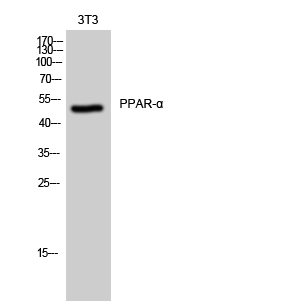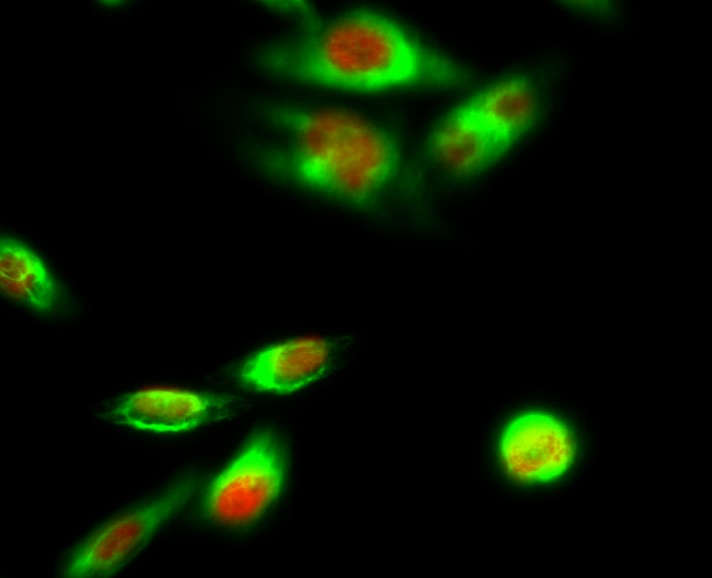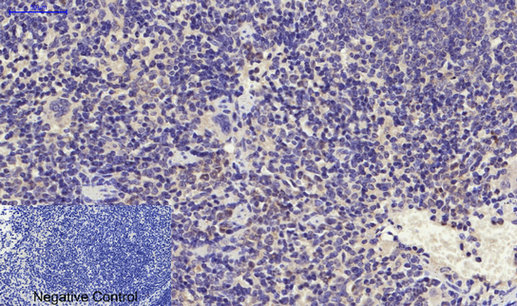


| WB | 咨询技术 | Human,Mouse,Rat |
| IF | 咨询技术 | Human,Mouse,Rat |
| IHC | 1/50-1/100 | Human,Mouse,Rat |
| ICC | 1/50-1/200 | Human,Mouse,Rat |
| FCM | 咨询技术 | Human,Mouse,Rat |
| Elisa | 1/10000 | Human,Mouse,Rat |
| Aliases | PPARA; NR1C1; PPAR; Peroxisome proliferator-activated receptor alpha; PPAR-alpha; Nuclear receptor subfamily 1 group C member 1 |
| Entrez GeneID | 5465 |
| WB Predicted band size | Calculated MW: 52 kDa; Observed MW: 52 kDa |
| Host/Isotype | Rabbit IgG |
| Antibody Type | Primary antibody |
| Storage | Store at 4°C short term. Aliquot and store at -20°C long term. Avoid freeze/thaw cycles. |
| Species Reactivity | Human,Mouse,Rat |
| Immunogen | The antiserum was produced against synthesized peptide derived from human PPAR-alpha. AA range:6-55 |
| Formulation | Purified antibody in PBS with 0.05% sodium azide,0.5%BSA and 50% glycerol. |
+ +
以下是3篇与PPARα抗体应用相关的文献摘要概括:
1. **"Tissue-specific actions of PPARα in lipid metabolism"**
*作者:Kersten S, et al.*
摘要:研究使用PPARα特异性抗体(Western blot验证)分析不同组织中PPARα蛋白表达,发现其在肝脏和心脏中高表达,并调控脂肪酸氧化基因。
2. **"PPARα deficiency suppresses immune response through mitochondrial dysfunction"**
*作者:Delerive P, et al.*
摘要:通过免疫组化(PPARα抗体染色)和基因敲除模型,证实PPARα在巨噬细胞炎症反应中的作用,抗体特异性经KO小鼠组织验证。
3. **"Validation of PPARα antibody for chromatin immunoprecipitation (ChIP)"**
*作者:Mandard S, et al.*
摘要:报道一种经ChIP验证的PPARα抗体,证明其可特异性结合靶基因启动子区域,并通过siRNA敲低实验确认抗体信号可靠性。
4. **"PPARα agonist effects on non-alcoholic fatty liver disease"**
*作者:López-Velázquez JA, et al.*
摘要:利用PPARα抗体(货号ab8934)进行肝组织免疫荧光分析,揭示药物激活PPARα后改善脂质沉积的分子机制,抗体经肽段竞争实验验证特异性。
注:以上为示例性概括,实际文献需通过PubMed/Google Scholar检索关键词"PPAR alpha antibody validation"或结合具体研究领域筛选。建议优先选择包含抗体货号、验证数据(如KO对照)及明确应用场景(WB/IHC/ChIP)的论文。
Peroxisome proliferator-activated receptor alpha (PPARα) is a nuclear receptor and ligand-activated transcription factor that plays a central role in regulating lipid metabolism, energy homeostasis, and inflammatory responses. It is predominantly expressed in tissues with high fatty acid catabolism, such as the liver, heart, and skeletal muscle. PPARα activates target genes involved in β-oxidation, lipoprotein metabolism, and glucose regulation by binding to specific DNA response elements as a heterodimer with retinoid X receptor (RXR). Its activation by endogenous ligands (e.g., fatty acids) or synthetic agonists (e.g., fibrates) makes it a therapeutic target for metabolic disorders, including dyslipidemia and atherosclerosis.
PPARα antibodies are essential tools for studying its expression, localization, and function in both physiological and pathological contexts. These antibodies are widely used in techniques like Western blotting, immunohistochemistry, chromatin immunoprecipitation (ChIP), and immunofluorescence to quantify protein levels, assess tissue distribution, or investigate transcriptional regulation. Specificity and validation are critical, as PPARα shares structural homology with other PPAR isoforms (β/δ and γ). High-quality antibodies are often validated using knockout models or siRNA-mediated silencing to confirm target specificity. Research applications span metabolic diseases, cancer (where PPARα may influence cell proliferation), and cardiovascular disorders, reflecting its multifaceted role in cellular metabolism and disease pathways.
×